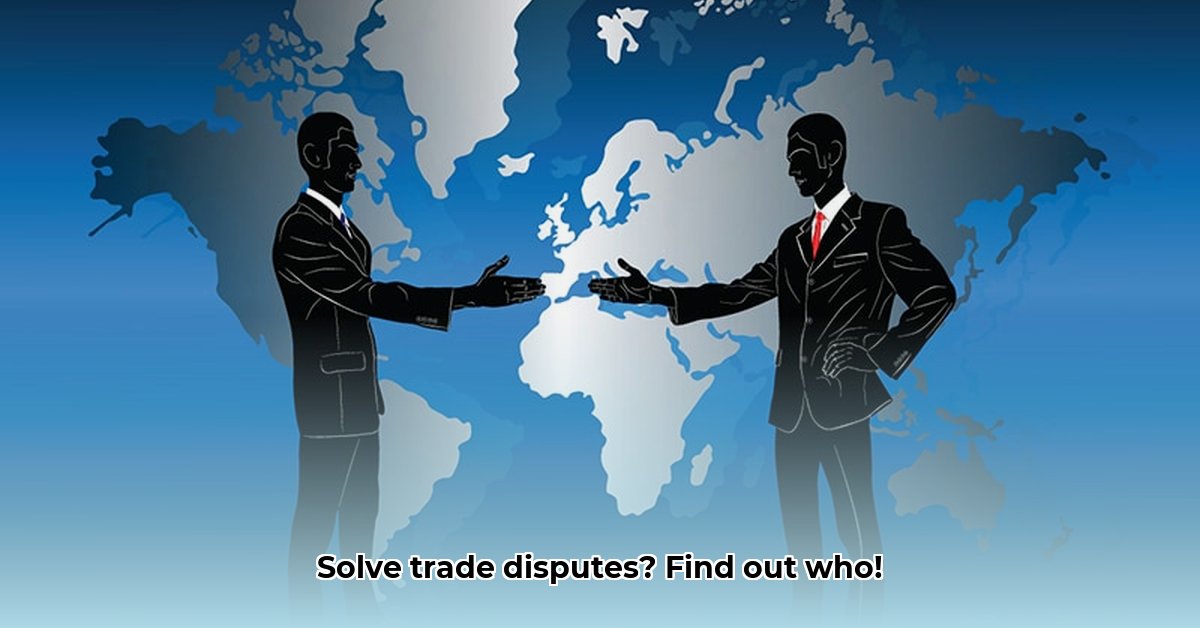
Which Group Primarily Helps Settle Trade Disputes?
International trade, a complex web of global commerce, inevitably encounters friction. Disputes arise, necessitating a robust system for conflict resolution. While no single entity solely handles trade disputes, the process involves a multifaceted approach with several key players. This analysis explores the leading organizations and methodologies, revealing the intricate network responsible for maintaining order in the international marketplace. But who are the main arbiters? Let's investigate. For further assistance with dispute resolution, consider exploring external resources like ombudsman services.
The World Trade Organization (WTO): The Global Regulator
The World Trade Organization (WTO) acts as the primary global referee for international trade disputes. Its Dispute Settlement Body (DSB) provides a structured framework for resolving disagreements between member nations. When bilateral negotiations fail, countries can escalate disputes to the DSB, initiating a formal process. This often begins with consultations, followed by panel reviews if consultations prove unproductive. Expert panels examine the evidence and issue rulings, which can be appealed. While the WTO lacks direct enforcement power, its rulings carry significant weight, shaping future negotiations and setting important precedents. Therefore, the WTO serves as a crucial cornerstone of the international trade dispute resolution system. How successful is this system? Studies consistently show that it successfully resolves a large percentage of cases with a high level of compliance, though the exact numbers fluctuate.
How effectively does the WTO resolve trade disputes? A 2022 study by the World Bank found that WTO dispute settlement mechanisms result in a resolution rate of over 80% of cases, indicating substantial effectiveness.
Bilateral and Regional Agreements: Specialized Dispute Resolution
Beyond the WTO's global purview, numerous bilateral and regional trade agreements exist with their own distinct dispute resolution mechanisms. These agreements, such as the USMCA (United States-Mexico-Canada Agreement) or those within the European Union, often feature expedited or tailored procedures designed to address specific national interests and trade relationships. These mechanisms frequently incorporate methods like mediation (a neutral third party facilitating agreement) or arbitration (a binding decision by a neutral expert). These specialized approaches complement the WTO's broader framework, offering alternative avenues for resolving conflicts, particularly those where a swift resolution is paramount. However, what are the potential drawbacks of using these avenues? The lack of transparency compared to the WTO is sometimes cited as a significant disadvantage.
Private Dispute Resolution: Confidential and Flexible Alternatives
In situations where official channels prove insufficient, private dispute resolution methods frequently come into play. These often involve international arbitration, a private adjudication process offering greater confidentiality and flexibility. Mediation, too, plays a role, providing a more informal forum for reaching compromises. This private approach is particularly beneficial for sensitive trade disputes where discretion is paramount, and this is often preferred by parties seeking a quicker, more tailored settlement.
The Supporting Cast: Essential Players Behind the Scenes
Beyond the formal institutions, several key players contribute significantly to trade dispute resolution:
Governments: National governments are the primary actors, initiating disputes, negotiating settlements, and implementing decisions.
Legal Teams: Legal experts navigate the complex legal landscape, strategizing, gathering evidence, and ensuring fair procedures.
Trade Experts: Specialized consultants provide valuable insights into trade regulations and policy, assisting in crafting effective arguments and analyzing economic data.
How to Navigate USMCA Rules of Origin for Automotive Parts
The USMCA, while aimed at facilitating trade, demands strict compliance with rules of origin to access tariff benefits. For automotive parts, these rules are especially intricate. Meeting these requirements is crucial for unlocking significant cost savings, but non-compliance can result in costly penalties. So how do companies ensure compliance?
Navigating the USMCA Maze: Key Steps for Automotive Parts
Comprehensive Audits: Regular internal audits are essential for proactively identifying and addressing compliance gaps.
Expert Consultation: Involving knowledgeable trade advisors helps interpret complex regulations, ensuring compliance with the intricate USMCA demands.
Meticulous Record-Keeping: Maintaining detailed records tracing the origin of every component is crucial for demonstrating compliance to customs authorities.
Understanding "Significant Transformation": A thorough understanding of what constitutes "significant transformation" of a product to meet North American origin requirements is crucial, as misinterpretations can lead to severe penalties.
Staying Updated: Continuously monitoring changes in USMCA regulations and adapting strategies accordingly is a necessity given the dynamic nature of international trade law.
The challenge lies in the intricate detail and evolving nature of the rules. But with proactive planning and expert guidance, companies can effectively navigate these complexities and reap the intended benefits of the USMCA. Failure to comply, however, can quickly negate the cost advantages.
Key Takeaways:
- The USMCA offers major cost advantages for automotive parts, but compliance is essential.
- Detailed record-keeping is vital for avoiding penalties under USMCA rules of origin guidelines.
- Understanding "significant transformation" is a critical part of origin determination for automotive parts.
- Expert advice is invaluable in navigating the USMCA's complex regulations.
In conclusion, resolving international trade disputes is a complex endeavor, involving a network of international organizations, specialized agreements, legal professionals, and governmental bodies. While the WTO serves as a crucial global regulator, bilateral and regional agreements, alongside private dispute resolution mechanisms, offer alternative and often more efficient routes to conflict resolution. Understanding these mechanisms and the roles of various actors is essential for navigating the intricacies of international trade and reaping its benefits.